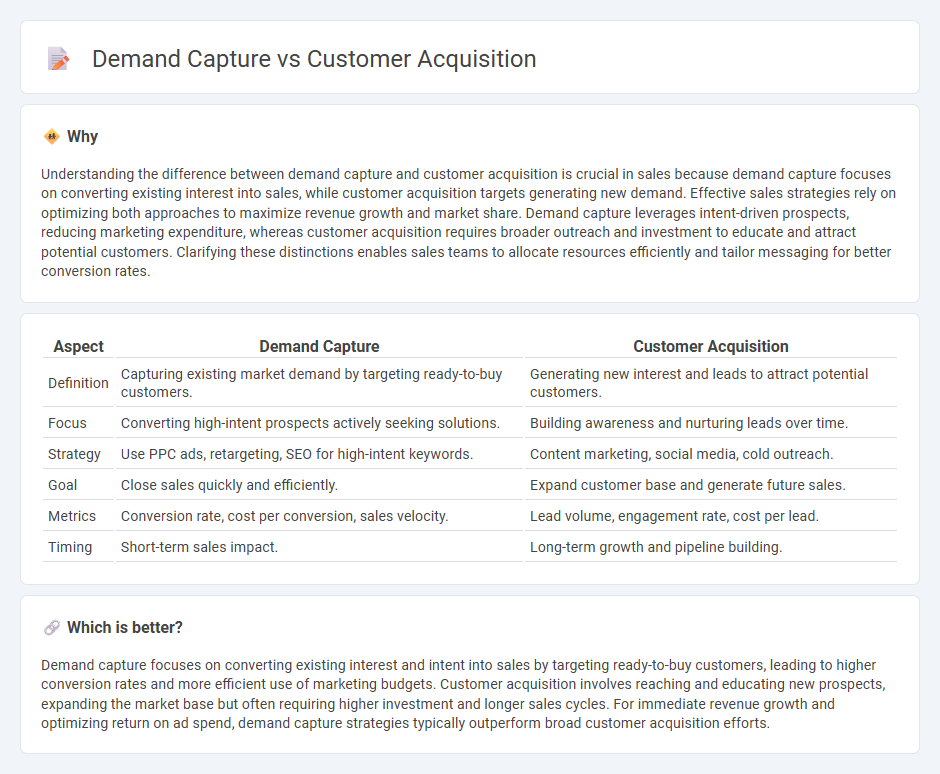
Demand capture focuses on converting existing interest into sales by targeting customers actively seeking products or services, whereas customer acquisition involves generating new leads and broadening market reach. Effective sales strategies balance both approaches to maximize revenue and growth. Explore how integrating demand capture and customer acquisition can transform your sales performance.
Why it is important
Understanding the difference between demand capture and customer acquisition is crucial in sales because demand capture focuses on converting existing interest into sales, while customer acquisition targets generating new demand. Effective sales strategies rely on optimizing both approaches to maximize revenue growth and market share. Demand capture leverages intent-driven prospects, reducing marketing expenditure, whereas customer acquisition requires broader outreach and investment to educate and attract potential customers. Clarifying these distinctions enables sales teams to allocate resources efficiently and tailor messaging for better conversion rates.
Comparison Table
| Aspect | Demand Capture | Customer Acquisition |
|---|---|---|
| Definition | Capturing existing market demand by targeting ready-to-buy customers. | Generating new interest and leads to attract potential customers. |
| Focus | Converting high-intent prospects actively seeking solutions. | Building awareness and nurturing leads over time. |
| Strategy | Use PPC ads, retargeting, SEO for high-intent keywords. | Content marketing, social media, cold outreach. |
| Goal | Close sales quickly and efficiently. | Expand customer base and generate future sales. |
| Metrics | Conversion rate, cost per conversion, sales velocity. | Lead volume, engagement rate, cost per lead. |
| Timing | Short-term sales impact. | Long-term growth and pipeline building. |
Which is better?
Demand capture focuses on converting existing interest and intent into sales by targeting ready-to-buy customers, leading to higher conversion rates and more efficient use of marketing budgets. Customer acquisition involves reaching and educating new prospects, expanding the market base but often requiring higher investment and longer sales cycles. For immediate revenue growth and optimizing return on ad spend, demand capture strategies typically outperform broad customer acquisition efforts.
Connection
Demand capture directly influences customer acquisition by identifying potential buyers and converting their intent into actionable sales opportunities. Effective demand capture strategies utilize data analytics and targeted marketing to engage prospects at the right moment in the buying cycle. This seamless connection ensures higher conversion rates and optimizes the sales funnel from lead generation to customer onboarding.
Key Terms
Lead Generation
Customer acquisition emphasizes attracting new prospects through targeted marketing strategies, while demand capture focuses on converting existing interest into qualified leads. Lead generation plays a critical role in both by driving potential customers into the sales funnel through content marketing, SEO, and paid campaigns. Discover effective techniques to optimize lead generation for maximizing customer acquisition and demand capture.
Conversion Rate
Customer acquisition strategies aim to attract new leads through targeted campaigns, while demand capture focuses on converting existing interest into sales with optimized touchpoints. Conversion rate serves as a key metric to evaluate effectiveness, indicating how well efforts turn prospects into paying customers. Explore advanced techniques to boost conversion rates and balance customer acquisition with demand capture for maximum growth.
Sales Funnel
Customer acquisition targets potential customers at the top of the sales funnel by generating awareness and attracting interest through marketing strategies, while demand capture focuses on engaging prospects who are ready to purchase, typically in the decision phase. Optimizing the sales funnel involves aligning marketing efforts to guide leads smoothly from awareness to conversion, maximizing the efficiency of both acquisition and demand capture. Explore deeper insights into balancing these strategies to accelerate revenue growth and enhance customer lifecycle value.
Source and External Links
What is Customer Acquisition? - IBM - Customer acquisition is the set of strategies and processes businesses use to attract, nurture, and convert new customers into paying clients, focusing on creating a sustainable pipeline for long-term growth by targeting the most loyal and profitable customers.
What Is Customer Acquisition? The Complete Guide - Salesforce - Customer acquisition involves identifying potential customers and using acquisition marketing tactics such as online ads, SEO, content, and email marketing to generate and nurture leads with the goal of converting them into paying customers and expanding the business.
Customer acquisition strategies to grow your business - Adobe - Effective customer acquisition strategies include SEO, content marketing, email marketing, and social media marketing, which help attract and engage target audiences through various channels to convert them into customers.
 dowidth.com
dowidth.com